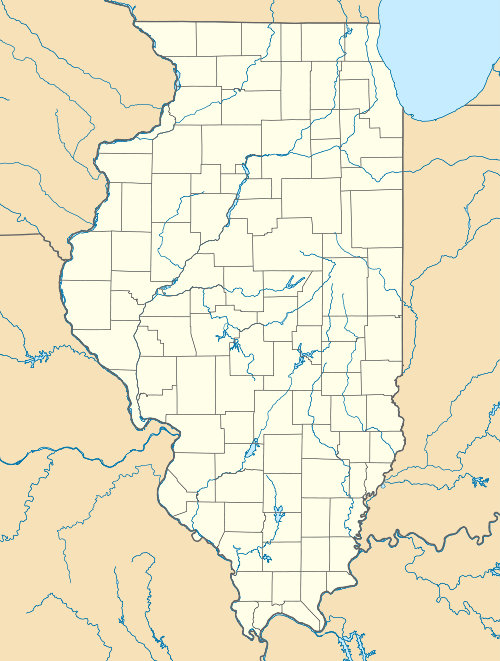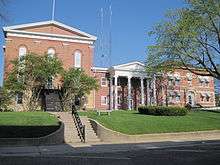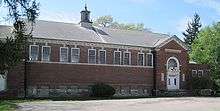Mount Carroll Historic District
|
Mount Carroll Historic District | |
|
Market Street in downtown Mount Carroll. | |
  | |
| Location | Mount Carroll, Carroll County, Illinois, USA |
|---|---|
| Coordinates | 42°05′31″N 89°58′49″W / 42.09194°N 89.98028°WCoordinates: 42°05′31″N 89°58′49″W / 42.09194°N 89.98028°W |
| Area | 118 acres (48 ha) |
| Built | c. 1850-1924 |
| Architect | Various |
| NRHP Reference # | 80001340[1] |
| Added to NRHP | November 24, 1980 |
The Mount Carroll Historic District is a designated historic district in the Carroll County, Illinois town of Mount Carroll, which is the county seat. The district is listed on the National Register of Historic Places (NRHP), and is one of a total six sites in the county included on the Register.
The district was added to the NRHP in 1980. One building within the district, the Carroll County Courthouse, had already been added to the NRHP in 1973.[2]
The District is divided into three major sections: the traditional downtown of Mount Carroll, including the courthouse, library and business district; a residential area to the south of the downtown; and further south, the historic original campus of Chicago's Shimer College, now occupied by the Campbell Center for Historic Preservation Studies. The great majority of the buildings in the first two sections date from before 1900. Due to a fire that destroyed the original Mount Carroll Seminary campus in 1906, all of the Shimer campus buildings are from the 20th century, but most date from before 1930.[3]
NRHP-listed structures that are located within Mount Carroll but not included in the district are the Caroline Mark House and Nathaniel Halderman House.
Buildings and structures
The District's boundaries include a total of 272 buildings and structures, of which 81 have been assessed to have particular architectural and historic significance.[2]
| Listing number[2] | Name | Street address | Year built | Architect | Notes |
|---|---|---|---|---|---|
| 1 | Commercial block | 207-209 W. Market | Unknown | ||
| 2 | Commercial block | 408 N. Carroll | Unknown | ||
| 3 | A.N. Lichty Building | 106 W. Market | 1865 | ||
| 4 | Samuel J. Campbell Building | 108-112 W. Market | 1865 | ||
| 5 | Galena Street Bridge | Unknown | Wrought Iron Bridge Company. | ||
| 6 | Carroll County Courthouse | Market & Main |
1858 | William B. Olmsted & Peter A. Nicholson | |
| 7 | Glenview Hotel | Market & Clay |
1886 | ||
| 8 | Robert M.A. Hawk Residence | 115 N. Clay | approx. 1867 | Hawk was the only sitting US representative to ever reside in Carroll County. | |
| 9 | Uriah Green Residence | 105 N. Clay | 1873 | ||
| 10 | S.J. Campbell Sr. Residence II | 202 N. Main | 1875 | ||
| 11 | B.H. and James S. Hallett Residence | 209 S. Main | 1856 | ||
| 12 | Nelson Rinedollar Residence | 306 S. Main | 1877 | ||
| 13 | Hiram Colehour Residence | 316 S. Main | 1860 | ||
| 14 | John M. Stowell Residence | 413 S. Main | 1860 | ||
| 15 | John G. Blake Residence | 210 E. Broadway | 1861 | ||
| 16 | Owen P. Miles Residence II | 107 W. Broadway | 1873 | ||
| 17 | S.J. Campbell II Residence | 111 W. Broadway | 1925 | Carroll A. Klein | |
| 18 | Philander Seymour Residence | 512 S. College | 1856 | ||
| 19 | Former campus of Shimer College (14 buildings) | from Seminary St. south between Clay & Jackson |
1903-1958 | Various | |
| 20 | Judge James Shaw Residence | 415 S. Clay | 1889 | Joseph Lyman Silsbee | James Shaw was a prominent local politician, serving three terms in the Illinois General Assembly including one as Speaker of the House |
| 21 | Jesse M. Shirk | 304 E. Broadway | 1867 | ||
| 22 | Ansel Bailey Residence | 402 S. Clay | 1873 | ||
| 23 | David Emmert House | Clay & State | 1842 | David Emmert was co-founder and earliest settler of Mount Carroll | |
| 24 | Commercial block | 101 W. Market | Unknown | ||
| 25 | Commercial block | 105 W. Market | Unknown | ||
| 26 | Commercial block | 113 W. Market | Unknown | ||
| 27 | Commercial block | 318 N. Main | Unknown | ||
| 28 | Commercial block | 100-102 W. Market | Unknown | ||
| 29 | Commercial block | 308 N. Main | Unknown | ||
| 30 | George A. Stanton Building | 310 N. Main | 1896 | ||
| 31 | Commercial block | 314-316 N. Main | Unknown | ||
| 32 | Carnegie Library | Main & Rapp |
1907 | ||
| 33 | Commercial block | 115 W. Market | Unknown | ||
| 34 | J.H. Bushy Plats | 207-217 E. Market | 1901 | ||
| 35 | Commercial block | 114 W. Market | Unknown | ||
| 36 | Charles Philips Block | 116-118 W. Market | 1871 | ||
| 37 | William Miller block | 120 W. Market | 1871 | William T. Miller was a representative in the Illinois legislature | |
| 38 | SS. John and Catherine Church | 714 S. Jackson | Unknown | ||
| 39 | Edwin McAffee Residence | 504 S. College | 1861 | ||
| 40 | B.L. Shirk Residence | 516 S. College | 1862 | ||
| 41 | A.B. Adams Residence | 505 S. College | 1894 | ||
| 42 | Residence | 611 S. Clay | Unknown | ||
| 43 | Nathaniel H. Melendy Residence | 401 S. Main | 1871 | ||
| 44 | Harvey B. Woods Residence | 504 S. Lester | 1902 | ||
| 45 | John F. Hess Residence | 102 W. Broadway | a. 1855 | ||
| 46 | George Rea Residence | Broadway & Clay | 1872 | ||
| 47 | John W. Squires Residence | 501 S. West | 1902 | ||
| 48 | Oliver Swartz Residence | 212 E. State Rd. | 1858 | ||
| 49 | S.B. Emmons Residence | 314 S. Clay | 1870 | ||
| 50 | James O'Brien Residence | 302 S. Clay | 1856 | ||
| 51 | John H. Lafferty Residence | 311 S. Clay | 1887 | ||
| 52 | Hannah Colehour Residence | 309 S. Clay | 1854 | ||
| 53 | Joseph Ogden Residence | 210 S. Clay | 1873 | ||
| 54 | Residence | 209 S. Clay | Unknown | ||
| 55 | Robert Campbell Residence | 208 S. Main | 1888 | ||
| 56 | Emanuel Feaser Residence | 211 S. Main | 1856 | ||
| 57 | John Nycum Residence | 105 S. Clay | 1858 | ||
| 58 | Daniel Palmer Residence | 107 S. Main | 1873 | ||
| 59 | David Nelson Residence | 101 S. Main | 1859 | ||
| 60 | John Christian Residence | 108 N. Main | 1856 | ||
| 61 | Nathan Jacobs Residence | 102 N. Main | 1856 | ||
| 62 | Community House | 101 N. Main | 1860 | ||
| 63 | William Halderman Residence | 109 N. Main | 1855 | ||
| 64 | Residence | 205 N. Main | Unknown | ||
| 65 | S.H. Eby Residence | 106 N. Clay | 1864 | ||
| 66 | Dr. D.M. Greeley Residence | 111 N. Clay | 1873 | ||
| 67 | George Emmert Residence | 107 N. Clay | 1873 | ||
| 68 | S.J. Campbell Sr. Residence I | 204 N. Main | 1856 | ||
| 69 | Mrs. Lillie J. Kinney Residence | 505 S. Porter | c. 1900 | ||
| 70 | Reuben R. Watson Residence | 508 S. Porter | 1901 | ||
Shimer College campus
The buildings of the erstwhile Shimer College campus are chiefly in the Georgian Revival style; they form a traditional college quadrangle. Two buildings that formed part of the Shimer College campus, but were built after 1960, are omitted from the Historic District: these are the Karyn Kupcinet Playhouse and the New Men's Dorm, both of which are separated from the rest of the campus by Jackson Street.
Since Shimer's departure in 1978, the campus has been occupied by the Campbell Center for Historic Preservation Studies, originally known as the "Restoration College". The buildings are used for administrative, classroom, and lodging purposes, but also serve as subject matter for the study and practice of historic preservation.
| Listing number[2] | Name | Image | Year built | Architect | Notes |
|---|---|---|---|---|---|
| 19a | Sawyer House | 1925 | C.A. Eckstrom | President's residence | |
| 19b | Metcalf Hall |  |
1907 | C.A. Eckstrom | Main administrative building |
| 19c | Dearborn Hall |  |
1903 | Music building | |
| 19d | Campbell Library |  |
1925 | C.A. Eckstrom | |
| 19e | Hostetter Hall |  |
1906 | C.A. Eckstrom | Dormitory |
| 19f | Hathaway Hall |  |
1905 | C.A. Eckstrom | Dormitory |
| 19g | Infirmary |  |
1913 | C.A. Eckstrom | |
| 19h | McKee Hall |  |
1906 | C.A. Eckstrom | Dormitory; named for William Parker McKee |
| 19i | Bennett Hall |  |
1909 | C.A. Eckstrom | Dormitory |
| 19j | Gymnasium |  |
1928 | H.A. Anderson | |
| 19k | Tolman Hall (Science Hall) |  |
1913 | C.A. Eckstrom | |
| 19l | Howe Hall | 1957 | Mittelbusher & Toutelot | Dormitory | |
| 19m | Steam Plant |  |
1911 | C.A. Eckstrom | |
| 19n | Dezendorf Hall |  |
1957 | Mittelbusher & Toutelot | Dormitory |
References
- ↑ National Park Service (2010-07-09). "National Register Information System". National Register of Historic Places. National Park Service.
- 1 2 3 4 Robert Wagner (1980). "National Register of Historic Places Inventory—Nomination Form" (PDF). Retrieved 2013-05-22.
- ↑ Rosabel Glass (1950). Shimer College History 1853-1950.
